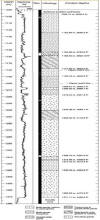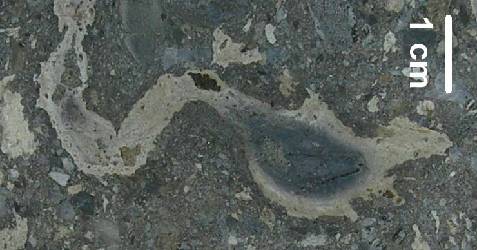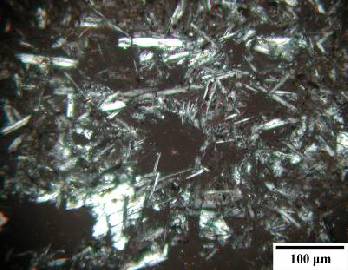Melt in the impact breccias from the Eyreville drill
cores, Chesapeake Bay impact structure
K. Bartosova, L. Hecht, Ch. Koeberl, E. Libowitzky and
U. Reimold; Meteoritics & Planetary Science 46, Nr 3, 396�430 (2011)
The center of the Chesapeake Bay impact structure was drilled during 2005⁄2006
in an ICDP-USGS drilling project. The Eyreville drill cores include polymict
impact breccias and associated rocks (1397�1551
m depth). Tens of melt particles from these impactites were studied
by optical and electron microscopy, electron microprobe, and microRaman
spectroscopy, and classified into six groups:
- m1� clear or brownish melt,
- m2� brownish melt altered to phyllosilicates,
- m3� colorless pure silica melt,
- m4� melt with pyroxene and plagioclase crystallites,
- m5� dark brown melt,
- m6� melt with globular texture.
Type m1 is a clear or brownish
melt, relatively homogeneous, slightly altered, with totals of ~87 wt%,
and ~77 wt% SiO2.
Type m2 is a brownish melt, totally
altered to phyllosilicate minerals, inhomogeneous, with abundant undigested
clasts, and with low totals of ~80 wt%, and ~56 wt% SiO2.
Type m3 is a colorless melt with some
brownish stains, with >95 wt% SiO2 and totals close to 100 wt%.
Melt type m4, with pyroxene and plagioclase
crystallites, forms matrix in the impact melt rocks and has approximately
75 wt% SiO2 and totals close to 100 wt%.
Dark brown melt particles of type m5
have commonly undigested clasts, only 54 wt% SiO2, and the highest contents
of Al2O3 and FeO; totals are approximately 91 wt%.
The last melt type m6, brownish melt
with typical globular texture, occurs exclusively in the upper impact
melt rock interval; it has 75 wt% SiO2 and the totals are approximately
96 wt%.
The melt particle types exhibit rather distinct, yet partly overlapping
chemical compositions. However, compositions are quite variable among
melt particle types and individual melt particles of one type. Particles
display primary compositional differences (e.g., schlieren) due to mixing
of melt phases with different composition, and irregular distribution
of crystallites and undigested clasts. There are also secondary changes
due to hydrothermal alteration�the melt particles were altered to phyllosilicate
minerals, and secondary zeolites and anatase formed. Parts of the silica
melt recrystallized to ballen quartz, and rare ballen cristobalite was
also noted. Except for the nearly pure silica melt (melt type m3), no
mono-mineralic melts were found. The chemical analyses and mixing calculations
suggest that many of the melt types are relatively silica-rich. The pre-event
impact sedimentary formations (e.g., those similar to rocks from the Cretaceous
age) seem to have been main components for the melt types m1, m4 and m6.
The basement-derived schist or gneiss could also be a precursor for some
melt types (namely the most abundant melt types m2 and m5) according to
the calculations. However, microscopic observations of some partly melted
clasts and comparison of chemical composition of the melt particles and
sedimentary clasts from the Eyreville drill cores suggest that melt types
m2 and m5 possibly formed from a fine-grained, clay-rich sediment. Melt
type m3 is melted quartz, quartzite, or quartz arenite.
We suggest that the pre-event impact sediments are the most important
precursors for the identified melt types. The sediments constituted a
large part of the target (1 km thick) and were probably largely melted
or vaporized. However, according to the diagrams and mixing calculations
and given the dimensions of the crater, a crystalline basement (probably
schist ⁄ gneiss) precursor could have been involved in formation of some
melt particles. The composition of the melt particles is highly variable
and does not indicate a uniform homogenized melt source.
Alteration could have substantially changed the composition (by, e.g.,
leaching of cations) of most melt types and makes the estimation of the
melt precursors difficult. The Eyreville drill cores provide only a limited
suite of samples for such a large impact structure and it is possible
that other types of melt particles or even larger melt bodies are present
in other parts of the Chesapeake Bay impact structure.
Monoclinic tridymite in clast-rich impact melt rock from the Chesapeake
Bay impact structure
J.C. Jackson, J. Wright Horton, I-M. Chou, H. E. Belkin;
American Mineralogist (2011)
X-ray diffraction and Raman spectroscopy confirm a rare terrestrial
occurrence of monoclinic tridymite in clast-rich impact melt rock from
the Eyreville B drill core in the Chesapeake Bay impact structure. The
monoclinic tridymite occurs with quartz paramorphs after tridymite and
K-feldspar in a microcrystalline groundmass of devitrified glass and Fe-rich
smectite. Electron-microprobe analyses revealed that the tridymite and
quartz paramorphs after tridymite contain different amounts of chemical
impurities. Inspection by SEM showed that the tridymite crystal surfaces
are smooth, whereas the quartz paramorphs contain irregular tabular voids.
These voids may represent microporosity formed by volume decrease in the
presence of fluid during transformation from tridymite to quartz, or skeletal
growth in the original tridymite. Cristobalite locally rims spherulites
within the same drill core interval. The occurrences
of tridymite and cristobalite appear to be restricted to the thickest
clast-rich impact melt body in the core at 1402�1407.5 m depth.
Their formation and preservation in an alkali-rich, high-silica melt rock
suggest initially high temperatures followed by rapid cooling.
Petrology of impact melt rocks from the Chesapeake Bay crater
A.Wittmann, R. Schmitt, L. Hecht, D. Kring, U. Reimold,
H. Povenmire; Geological Society of America, Special Paper 458 (2009)
In drill core Eyreville B, the section of pre-resurge impactites (depth
of 1397-1551m) includes bodies of clast-rich, unbreccieted impact melt
rock of depths of 1402-1409.5 m as holocrystalline and at 1450-1451.5
m as hypocrystalline varieties. These bodies contain more massive impact
melt rock in their central parts, from 1450 to 1451.5 m (M1), and between
1402 and 1407.5 m (M2).
Hypocrystalline clast-rich impact melt rock (M1):
Macroscopically, M1 is composed of fluidal-textured, banded, clear
to brown melt (30-70vol%) that entrained lithic clasts. Dark, fluidal
streaks in the rocks are partly fused remains of the fine clastic debris
or mafic components that were mixed into the melt. Microscopically,
the melt exhibits some glassy, clear domains that are isotropic and intergrown
by zoned orthopyroxene crystals that exhibit single-lath and dendritic
and euhedral, spinel crystals. In clear melt streaks, brown, spherolitic
aggregates of radially intergrown aluminosilicate microphenocrysts are
present. Dark, aphanitic streaks of melt contain euhedral Fe-Ti-O crystals,
few fan-like plagioclase phenocrysts, and small, equant quartz clasts
in a scmectitic groundmass.
Most quartz clasts exhibit a dark, bubbly contact aureole against the
melt but no halo of pyroxene crystals. Deplectic quartz glass was recrystallized
to polycrystalline ballen-textured quartz. The Raman spectroscopy
indicated the presence of alpha-quartz.
Holocrystalline clast-rich impact melt rock (M2):
This mostly holocrystallin, clast-rich, banded, massive gray
impact melt rock is 5.5 m thick. Dark streaks are drawn out into discrete
strings and indicate little mixing with the typical gray melt matrix.
They are composed of similar components as the dark streaks in M1, except
for the smectite matrix, which is mostly overgrown with feldspar
crystals. Quartz clasts are generally subrounded, have a brownish tint,
and frequently display decorated PDFs. The M2 samples exhibit similar
phenocryst phases in the melt as M1. The melt rock matrix is fully crystallized.
Electron microprobe data of the melts:
The composition of clear, glassy melt was analyzed in pristine domains
of sample W84 from M1. The results indicate a peraluminous,
rhyolitic composition with a water content
of ~5%. The crystallized melt matrix in sample W61 from M2 indicate
a similar geochemical affinity.
Dark streaks in the melt rocks of M1 and M2 were analyzed. Analyses indicate
a reservoir for MgO, Al2O3, Fe and TiO2, whereas SiO2, Na2O3 and K2O are
dramatically depleted in the dark streaks compared to the composition
of the glassy, clear melt.
The ICDP-USGS Deep Drilling Project in the Chesapeake Bay Impact
Structure: Results from the Eyreville Core Holes
Ch. Koeberl, K. Miller, U. Reimold; Geological Society of America, Special
Paper 458, 2009
|

|
A 275-m-thick granite slab (1096-1371 m depth) is
clearly allochthonous. This granitic slab is heterogenous and consists
of four intermingled granite types:
- Gneissic biotite granite (mainly above 1216.5 m)
- Fine-grained biotite granite (widely dispersed)
- Medium- to coarse-grained biotite granite (mainly below 1216.5
m)
- A 7-m-thicvk basal zone of altered red biotite granite (below
1364 m)
The gneissic biotite granite has a sensitive high-resolution ion
microprobe (SHRIMP) U-Pb zircon age of 615 +/- 7 Ma (HORTON et al.
2007).
The medium- to coarse-grained biotite granite has a SHRIMP U-Pb zircon
age of 254 +/- 3 Ma (HORTON et al.)
Note:
Due to age determination,
the allochthonous character of this mega-block is proved (old granites
above, young granite below).
|
|
















